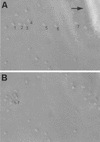Firm but slippery attachment of Deinococcus geothermalis
- PMID: 11948162
- PMCID: PMC135001
- DOI: 10.1128/JB.184.9.2473-2480.2002
Firm but slippery attachment of Deinococcus geothermalis
Abstract
Bacterial biofilms impair the operation of many industrial processes. Deinococcus geothermalis is efficient primary biofilm former in paper machine water, functioning as an adhesion platform for secondary biofilm bacteria. It produces thick biofilms on various abiotic surfaces, but the mechanism of attachment is not known. High-resolution field-emission scanning electron microscopy and atomic force microscopy (AFM) showed peritrichous adhesion threads mediating the attachment of D. geothermalis E50051 to stainless steel and glass surfaces and cell-to-cell attachment, irrespective of the growth medium. Extensive slime matrix was absent from the D. geothermalis E50051 biofilms. AFM of the attached cells revealed regions on the cell surface with different topography, viscoelasticity, and adhesiveness, possibly representing different surface layers that were patchily exposed. We used oscillating probe techniques to keep the tip-biofilm interactions as small as possible. In spite of this, AFM imaging of living D. geothermalis E50051 biofilms in water resulted in repositioning but not in detachment of the surface-attached cells. The irreversibly attached cells did not detach when pushed with a glass capillary but escaped the mechanical force by sliding along the surface. Air drying eliminated the flexibility of attachment, but it resumed after reimmersion in water. Biofilms were evaluated for their strength of attachment. D. geothermalis E50051 persisted 1 h of washing with 0.2% NaOH or 0.5% sodium dodecyl sulfate, in contrast to biofilms of Burkholderia cepacia F28L1 or the well-characterized biofilm former Staphylococcus epidermidis O-47. Deinococcus radiodurans strain DSM 20539(T) also formed tenacious biofilms. This paper shows that D. geothermalis has firm but laterally slippery attachment not reported before for a nonmotile species.
Figures





References
-
- Beech, I. B. 1996. The potential use of atomic force microscopy for studying corrosion of metals in the presence of bacterial biofilms. Int. Biodeterior. Biodegrad. 37:141-149.
-
- Beech, I. B., C. W. S. Cheung, D. B. Johnson, and J. R. Smith. 1996. Comparative studies of bacterial biofilms on steel surfaces using atomic force microscopy and environmental scanning electron microscopy. Biofouling 10:65-77. - PubMed
-
- Blanco, M. A., C. Negro, I. Gaspar, and J. Tijero. 1996. Slime problems in the paper and board industry. Appl. Microbiol. Biotechnol. 46:203-208.
-
- Bremer, P. J., G. G. Geesey, and B. Drake. 1992. Atomic force microscopy examination of the topography of a hydrated bacterial biofilm on a copper surface. Curr. Microbiol. 24:223-230.
Publication types
MeSH terms
LinkOut - more resources
Full Text Sources
Other Literature Sources
Molecular Biology Databases
Miscellaneous

